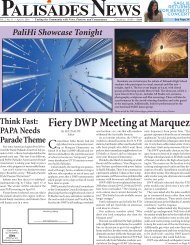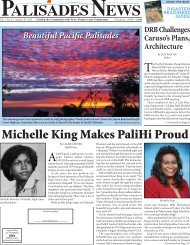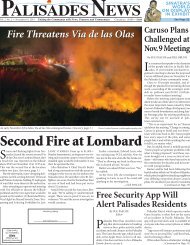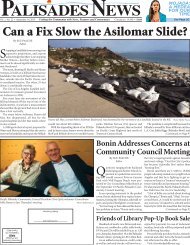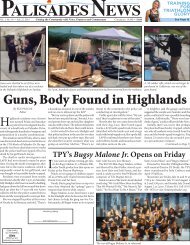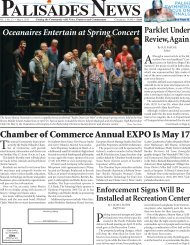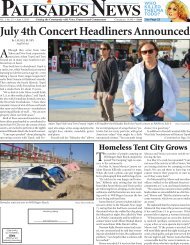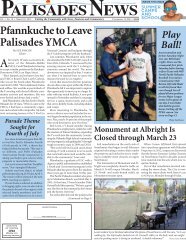<strong>Palisades</strong> <strong>News</strong>Page 22 <strong>July</strong> 8, <strong>2015</strong>Janis Joplin’s tambourine, mic, velvet top,bell-bottoms, feather boa and leather bag.Photo: Robert WedemeyerOnly Bill Graham would have the chutzpah to shoo Mick Jagger and Tina Turner offthe stage. He’s holding up one finger to indicate the duo has one minute left at Live Aid,Philadelphia, 1985.Photo: ©Lynn Goldsmith1980s Yamaha SG200 played and signed byCarlos Santana. Photo: Robert Wedemeyer‘Graham’ Offers Fascinating Rock HistoryBy LAURIE ROSENTHALStaff WriterAll photos courtesy Skirball Cultural CenterWalking into “Bill Graham and theRock & Roll Revolution” at theSkirball is akin to walking intoone of Graham’s renowned music venues—you may not know exactly what lies ahead,but you know you are in for a good time.Any concertgoer of a certain age wholived in New York or San Francisco—andbeyond—attended an event at the legendaryimpresario’s famed music palaces: FillmoreAuditorium (commonly referred to as FillmoreEast), Fillmore West or Winterland.Those fans a bit younger heard tall tales ofthose amazing halls and the iconic performerswho filled them with the sounds of a new eraas well as those from an almost forgotten one.The Skirball exhibit was four years in themaking, with the help of many individuals,including Graham’s sons, David and Alex,and former Bill Graham Presents staff, alongwith Skirball Director Robert Kirschnerand Curator Erin Clancey. It is an enthrallingtravelogue through Graham’s lifeand a lesson in American musical history.The trip begins in Germany, where hewas born Wulf Wolodia Grajonca in 1931and forced to flee with other Jewish childrenduring the Holocaust, taking an arduousjourney to America via France. In NewYork, at age 10 1 ⁄2, he was placed in an orphanage,where he was the last child chosen,eventually living with the Ehrenreichs,his Jewish foster family, in the Bronx.After a stint in the U.S. Army during theKorean War, Graham headed out west,landing in San Francisco at the dawn ofthe 1960s counterculture.“Bill Graham” runs somewhat chronologically,moving past Graham’s early years,through the 1960s, ‘70s and ‘80s, closingwith images of the free concert held inGolden Gate Park in his honor, after he andtwo others perished in a helicopter crashin 1991. Over 300,000 people came to paytribute, and some estimate the crowd wascloser to 500,000. (Ironically, Kirschner, aformer rabbi at Temple Emanu-El in SanFrancisco, officiated at Graham’s funeral.)A multimedia feast awaits visitors, witheye-popping psychedelic posters and handbills;guitars (both fragments and whole) ofsome of rock’s most revered players, suchas Jerry Garcia, Carlos Santana, Jimi Hendrixand Pete Townshend; video from TheLast Waltz and the Allman Brothers Bandat Fillmore East; and music continuallyplaying in the background.Graham was a master of mixing up thebill, offering young hippie kids the chance tonot only see their contemporaries, such as theGrateful Dead, Jefferson Airplane and MobyGrape, but an older generation of blues,jazz, soul and gospel musicians who had ahuge influence on rock & roll, including B.B.King, Muddy Waters and Otis Redding.When Aretha Franklin finally performedat Fillmore East, Graham derived greatpleasure from having an audience equallymixed between blacks and whites. “It wasone of the great nights of his life,” says Grahambiographer Robert Greenfield (Bill GrahamPresents: My Life Inside Rock and Out).He was also the first to integrate acts,which helped provide the eclectic eveningshis venues were known for. One show mightbe a mixture of Big Brother and the HoldingCompany and the Staples Singers, whileanother would feature Neil Young andMiles Davis. The creative blends were seeminglyendless.Graham put money back into his venues,(Continued on Page 23)In the midst of the counterculture, Graham was the one who had to keep order in chaoticsurroundings. He’s shown here onstage at Fillmore East, 1970.Photo: John Olson, The LIFE Picture Collection/Getty ImagesBob Dylan and Jerry Garcia at Day on the Green in Oakland, <strong>July</strong> 1987. Photo: Ken Friedman
<strong>July</strong> 8, <strong>2015</strong> <strong>Palisades</strong> <strong>News</strong> Page 23Graham used duct tape to mend KeithRichards’ boots during the Rolling Stones’1981 Tattoo You tour. Photo: Robert WedemeyerGraham(Continued from Page 22)always improving the sound, lighting andanything else that would enhance the concertgoers’experience.“People were there for the music, thedancing and the kinship,” says Erin Clancey,describing what drew them to early showsproduced by Graham.The memorabilia—some never beforeseen—includes Graham’s beginnings withthe San Francisco Mime Troupe, when hestaged the first of his many benefit concerts.Over the years, if someone needed helpwith a benefit, they would go to Graham:the Haight-Ashbury Free Medical Clinic,the San Francisco public school district, theAmerican leg of Live Aid, voter registrationdrives, Amnesty International and more.Remember that white suit Peter Framptonwore on the cover of Frampton ComesAlive!? It’s in the show, as are a pair of bootsKeith Richards wore—and Graham personallyfixed—during the Rolling Stones tourthat Graham managed in the early 1980s.They were a gift from the guitarist who, accordingto Greenfield, told Graham, “Bill,you’ve been a driving asshole, but you madeit happen. We’re never going to go on theroad without you again.”Additional highlights include clips fromGraham’s performances in feature films,including Apocalypse Now and Bugsy, anda menorah that was mostly destroyed whenGraham’s offices were firebombed by aMolotov cocktail in the 1980s. He lostmuch of his memorabilia in that fire.Clothing worn by Grace Slick and JanisJoplin, which Graham treasured, is alsoincluded in the exhibit.While Graham was always making sure hisconcerts were well run, New Year’s Eve waswhen he was in the limelight, coming out atmidnight during Grateful Dead shows. Twoof his costumes are on view (Father Time anda butterfly), decked out with Dead imagery.His custom-made, two time-zone watchhangs on the wall, an homage to the dayswhen he took the red-eye every Thursdayto work at Fillmore East all weekend beforereturning home to the Bay Area on Sunday,showing up for work Monday morning.Come Thursday, he would do it all again.This went on for about three years.There’s even a room that pays homageto the light shows that were a staple at manyGraham shows. Joshua White did lightDAN URBACH PRESENTSBill Graham as Father Time at the Grateful Dead’s New Year’s Eve concert at the OaklandColiseum in 1987.Photo: Ken Friedmanshows at Fillmore East, and created “TheJoshua Light Show” specifically for the Skirballexhibition, which is shown in a darkroom. If you feel the need to do some interpretativedancing, no one can really seeyour face, so let your freak flag fly.Graham’s Day on the Green series waspretty much the beginning of stadium rock,and Graham began producing the outdoorshows in 1973. Top acts of the day performed,such as The Who, Tower of Power, Aerosmith,Van Halen, AC/DC and Green Day.Graham’s sons, David and Alex, attendedthe recent press preview of the exhibit. Whenasked by the <strong>Palisades</strong> <strong>News</strong> about his father’slegacy, David, who’s on the board of the BillGraham Memorial Foundation, talked abouthow his father took action when he saw aninjustice in the world. “He didn’t just complain,he actually did something about it.”“Clearly he was a hardcore businessmanwhen he had to be, but at the end of theday, he was sort of everyone’s dad. And theincredibly ironic thing is that somebodywho was orphaned due to the Holocaustended up being this paternal figure toeverybody else.”In summing up his father, David said,“He did good.”“Bill Graham and the Rock & Roll Revolution”will be on view at the Skirball CulturalCenter through October 11. For moreinformation, visit www.skirball.org.GRACIOUSHIGHLANDS ESTATE16678 Via la Costa, Pacific <strong>Palisades</strong>Breathtaking 5bd/7.5ba ocn view Med estateon apprx ½ acre in the exclusive guard gatedEnclave. Exceptional 180 degree ocn & mtnviews. Resort-like backyard with pool. Membershipin Summit Club.www.EnclaveEstate.comOFFERED AT $6,250,000TRADITIONALCHARM644 Bienveneda Ave., Pacific <strong>Palisades</strong>Classic 4bd/3ba 2-story updated Cape Codin a beautiful tree lined cyn setting. Soaringceilings & lots of windows offer an abundanceof light. Meticulously landscaped bckyrd w/ outdoor kit & spa.www.644Bienveneda.comOFFERED AT $1,899,000BUILD YOUR DREAMHOME HERE1410 El Bosque Ct., Pacific <strong>Palisades</strong>Over 1/3 of an acre (per assr) on a quiet culde-sacin the Highlands. Plans for 5 bedroomand 5 ½ bathroom Mediterranean in 5,631SF with subterranean level, pool & spa.Membership in the <strong>Palisades</strong> Hills RecreationCenter with pool & tennis courts.OFFERED AT $1,850,000Call Dan Directly at: 310.230.3757Dan UrbachPalisadian and Realtorsince 1992.BRE #01147391Info@DanUrbach.com • www.ExclusiveRealtor.com881 Alma Real Drive, Suite 100, Pacific <strong>Palisades</strong>, CA 90272Dan was recently congratulated by John Closson, Vice President and Regional Manager of Berkshire Hathaway HomeServices, for being the“TOP PRODUCING” AGENT IN THE PACIFIC PALISADES OFFICE FOR 2014,as well as one of the “TOP TEN” AGENTS NATIONWIDE OUT OF MORE THAN 35,000 SALE PROFESSIONALS.
- Page 1 and 2: THESE BOOTSWERE MADEFORROCKIN’Vol
- Page 3 and 4: July 8, 2015 Palisades News Page 3T
- Page 5 and 6: July 8, 2015 Palisades News Page 5R
- Page 7: Palisades NewsJuly 8, 2015 A forum
- Page 10 and 11: Page 10 Palisades News July 8, 2015
- Page 12 and 13: Page 12 Palisades News July 8, 2015
- Page 14 and 15: Page 14 Palisades News July 8, 2015
- Page 16 and 17: Page 16 Palisades News July 8, 2015
- Page 18 and 19: Palisades NewsPage 18 July 8, 2015S
- Page 20 and 21: Page 20 Palisades News July 8, 2015
- Page 24 and 25: Page 24 Palisades News July 8, 2015
- Page 26 and 27: Page 26 Palisades News July 8, 2015
- Page 28: Page 28 Palisades News July 8, 2015




